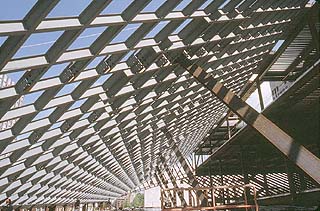
DJC.COM
May 20, 2004
Intuitive design yields unlikely results
Magnusson Klemencic Associates

Beaman
|
The offset platforms and sloping exterior surfaces convey the message that the structure required to keep the building from falling to the ground must be extremely complex and robust. However, even with all the geometric complexities and challenges, the structural system, like the building itself, is surprisingly pure in nature.
A process of “intuitive negotiation” between architect and structural engineer created a building that distills function and form to elemental basics: what is there is exactly what is needed — no more, no less.
The architect's initial vision for the library was a series of offset “platforms” with some form of “tension net” binding the platforms together.
Of course, the “offset” was based not on structural balance but rather locating the platforms to maximize views and capture desired light and shadow.

Photo courtesy of MKA
Sloping columns in the central library’s reading room help prop up the structural diamond grid. The areas in the center of the grid span, where the structural stresses are highest, were reinforced with a second layer of steel. |
The architect also wanted the platforms to appear to float in space, with no obvious form of support. Overall, uniformity was to be avoided and a sense of instability was actually desired.
Intuition rules
From early conceptual meetings through completion of construction drawings, both the architects and engineers used physical models to visualize and understand the building.
This process, which is becoming rare as technology leans towards computer rather than physical modeling, gave the design team a way to immediately develop a sense of and feel for the spaces they were creating. Given the nature of the building, it was difficult to describe and exchange ideas without the models.
Early discussions, which were very rudimentary in nature, made use of small foam blocks representing the primary building platforms.
Structural engineers inserted black stick pins into the foam-block building at locations intuitively calling for column support. The proposed columns were evaluated from architectural and structural viewpoints, then negotiated to determine whether they should be kept, re-oriented or discarded.
In the end, what remained was a very pure structural system, with elements located and oriented precisely where needed and eliminated where unnecessary.
Crooked concrete
The building's three primary structural systems — the concrete substructure, steel superstructure and diamond grid skin — were also developed using an intuitive approach.
The most striking element of the concrete substructure is the sloping columns in the children's and English-as-a-second-language areas of the Fourth Avenue entry level. While they may seem random or intended as an architectural expression, the column orientation is actually very purposeful.
The apparently whimsical orientation is the result of an efficient resolution of two disparate column grids: the column locations for the book stacks above and those for the parking garage below.
The “connect-the-dots” solution located the necessary structural elements in the most direct path from point A to point B, even if that resulted in sloping columns.
The solution is quite uncommon but actually more pure structurally than traditional approaches. In addition to providing a very exciting and dynamic building space, the sloping columns allow disparate column grids to remain in their optimum locations.
Floating steel
Above the Fifth Avenue entry, the three primary building platforms of the superstructure are significantly offset both vertically and horizontally.
As mentioned previously, a primary architectural objective was to produce the perception that the platforms were floating. To this end, several ground rules were established: use as few columns as possible at the edges of the platforms and, of those that are used, do not locate them at the corners and do not position them vertically.
Without vertical columns at traditional locations, the viewer's eye is instead drawn to the architecture of the platforms, which appear to be unsupported. Columns located parallel to the skin and painted to match the grid steel allow the diamonds and glass to take visual preference.
Spiraling floors
Another critical architectural element can be found in those levels containing the book collection.
The desire was for a continuous layout of the library's collection (organized by the Dewey Decimal system) so the number of books could grow or shrink without splitting sections between floors.
Knowing that a six-block-long continuous floor was impossible, a familiar solution was used in a very unfamiliar way. Taking the lead from parking garages, the book collection is located on a four-story “spiral,” allowing one to walk the entire collection without the need for stairs, elevators or escalators.
A skin of diamonds
The composition of the skin of the building, composed of the steel diamond grid and the exterior glass system, represents the coming together of numerous creative solutions.
One of the first questions answered was simply the size of the diamonds. The optimum diamond size was chosen by considering the maximum glass span, amount of glass-cutting waste, desired depth and width of the support structure, and fabrication and shipping considerations.
The resulting diamond grid system provides a skin that functions as the “tension net,” tying the offset platforms together. The grid system resists all wind and earthquake forces and supports the exterior envelope of the building without the need for a costly secondary mullion system.
Intervention support
Similarly unique solutions were implemented to support the diamond grid when the spans became too long.
In the 10th-floor reading room, for example, two solutions can be seen. The first is the sloping “intervention” columns that serve to prop up the diamond grid. This, too, uses a “connect-the-dots” approach, creating unusual column angles and lengths depending on the locations of point A and point B.
Once again, the desired architectural expression was achieved with a pure, exposed structure.
A second solution came to be known by the design and construction team as the “amoeba.”
The areas in the center of the diamond grid spans, where the structural stresses are the highest, called for additional strengthening. Rather than beefing up the entire span, a second layer of grid was added behind the primary grid.
Varying in shape and size, these strengthening amoebas were located only where needed and configured to match the stress patterns shown by structural analysis. This provides the necessary strength in a manner that is truly expressive of the grid system behavior.
Without question, the analysis and design of the structure for the new Seattle Central Library was extremely complex and challenging.
A thorough understanding of architectural desires, the use of familiar technologies in unfamiliar ways, and a very creative and collaborative process of negotiation and problem-solving achieved a purity of design for Seattle's newest icon.
Derek M. Beamon is a senior associate at Magnusson Klemencic Associates.
Other Stories:
- Do we really need libraries anymore?
- College libraries cater to widening needs
- Living rooms for urban neighborhoods
- Dozens of library projects on tap for Seattle, King County
- Libraries: the next must-have amenity
- Library's tech system is also daring and elegant
- Divining the cost of an oddball building
- Nuts and bolts shape the library's unique design
- Neighborhood libraries get big-city treatment
- Library lights lift a heavy load
Copyright ©2009 Seattle Daily Journal and DJC.COM.
Comments? Questions? Contact us.